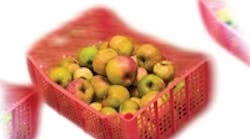Consumers are demanding more choices and lower prices than ever. Today’s consumers will quickly switch brand allegiances to get a better value.
To preserve margins while still meeting volatile consumer demand, many food and beverage retailers and wholesalers have had to reconfigure their behind-the-scenes distribution systems. Automation is one strategy to increase productivity and meet cost-reduction goals.
The following trends in particular are driving further investment in automated material handling systems in the food and beverage industry verticals.
1. Biomechanical injuries
Food and beverage distribution centers primarily handle case goods, which tend to be heavy, especially when a worker handles case loads for an entire shift. Injuries can be devastating to the health of workers, not to mention medical and absentee costs.
2. Need for speed and accuracy
Orders must be processed, picked and shipped with everincreasing speed. The trend remains: smaller shipments, more often. And, accuracy in order fulfillment is vital. Picking errors lead to customer dissatisfaction and high costs.
3. Spikes in throughput
Seasonal increases in throughput rates require the addition of seasonal labor. Seasonal labor can be difficult to hire, train, motivate and manage.
4. Growth of slow-moving SKUs
As SKU proliferation and volume increases, so does pressure to accommodate slow movers more efficiently. Slow movers, which make up the majority of SKUs, are taking up more and more space, even requiring a separate pick face.
5. Real-time control
Distribution center managers need to know exactly where every item is located in the distribution center as well as the ongoing status of the order fulfillment process.
6. Harsh working environments
Freezer storage often requires subzero temperatures. Legal restrictions require workers to be exposed to freezer environments for only limited periods of time. This increases costs in an already high-turnover environment. Freezer space also is costly to build and maintain, so solutions that minimize freezer space are ideal.
7. Space utilization
There are increasing demands to “use the cube”—provide more productivity in less space. That means new food distribution centers have to provide more throughput in a smaller building footprint. Existing food distribution centers must deal with more SKUs at a greater velocity within the existing building footprint.
8. Store ready
Food retailers have had to reduce instore labor and the time it takes to restock shelves with product. This trend is forcing distributors to ship store-ready product. Items must arrive at stores presorted and grouped by product family.
Retailers are operating numerous store formats in an effort to target consumer demographics. This requires fulfillment systems with greater flexibility to meet significantly different order profiles.
10. Reduced/green packaging
Environmental awareness affects the cost, type and quantity of packaging and packing material used in the supply chain. Distributors are moving away from roller conveying and toward all-belt conveying to accommodate less-robust packaging as well as small and irregularly shaped items.
11. RFID integration
The transition to RFID labeling of pallets, cases and items affects the methods by which product is received, put away, picked and shipped. As these methods are redesigned for integration with RFID, more efficient material handling techniques are also being considered.
12. Transportation costs
Rising oil prices are driving stricter fleet management and more streamlined warehouse operations. Warehouse control software with order management functions is optimizing order consolidation and trailer loading for better density.
In short, automation can be used in varying degrees to improve product flow and labor allocation, accommodate facility size and reduce overall operating costs. Technologies most often used in these applications include warehouse management systems, warehouse control systems, voice- and light-directed order fulfillment, automated storage/retrieval systems, package and pallet conveyors, sorters and trailer loaders.
By effectively applying automation and software, today’s food and beverage distribution centers can raise the bar on productivity while reducing costs, speeding up the process and improving customer service.
This article is based on a white paper from Grand Rapids, Mich.-based Dematic. For more information, call 877-725-7500 or visit www.dematic.us.
Conquering Complexity
Automated case picking reduces operating costs for a large grocery distributor.
| Buyer’s Box ASAP Automation BITO Lagertechnik Bittmann Daifuku America Corp. Dematic Corp. Diamond Phoenix Co. FKI Logistex Hanel Storage Systems HK Systems Knapp Logistics and Automation Murata Machinery USA Inc. Rehrig Pacific Co. Remstar International Inc. Retrotech Inc. SSI Schaefer Swisslog Logistics Inc. TGW-Ermanco Inc. Vertique Inc. Viastore Systems Inc. Westfalia Technologies Inc. Witron Integrated Logistics |
Retail distribution requires the efficient handling of thousands of products, all with different sizes, weights and packaging types. Conquering this complexity with automation has become somewhat of a Holy Grail in recent years. Material handling equipment suppliers are still searching for an ideal way to automate the handling of such variability.
Witron Integrated Logistics Corp., based in Parkstein, Germany, says it developed its order picking machinery (OPM) system specifically to meet the material handling demands of retail distribution.
One of the largest retail grocers in the U.S. recently selected Witron’s OPM system to automate its entire process, from receiving to shipping.
When pallets arrive at the grocer’s distribution center, they are immediately stored in an automated high bay warehouse (HBW). One or two days of inventory is buffered on trays in an automated small parts warehouse (ASW) that feeds the picking operation. The picking buffer is constantly replenished on the basis of current order data. Automated depalletizers strip layers of cases from the HBW pallets, and then each depalletized case is automatically loaded onto a plastic tray and stored in the ASW.
Witron’s pack-pattern software determines stacking sequence for the cases on each order pallet based on size, weight and family grouping rules. Trays are automatically transported from the picking buffer to a case order machine (COM) according to the predetermined sequence.
“The COM is the mechanical device that loads the order pallets with cases,” explains Helmut Prieschenk, chief executive officer of Witron. “The use of a sliding mechanism rather than a suction head or gripper allows up to 90% of the typical SKU range to be handled automatically.”
Cases are automatically separated from the trays at the COM and loaded onto the order pallet. Empty trays circulate back to the depalletizing area, while sensors monitor pallet building. The completed order pallet is transported via conveyor to an automatic stretch wrapping machine. Finally, the stretch wrapped order pallet is labeled and conveyed to shipping.
Witron notes that the ability to optimize pallet loading by considering size and weight constraints, store considerations and other diverse criteria, helps to maintain pallet stability and minimize case damage. In addition, the COM’s pallet loading technique reduces gaps, which can sometimes occur between cases. Reducing gaps between cases ensures the maximum number of cases is loaded on each pallet, and that can help reduce transportation costs.



